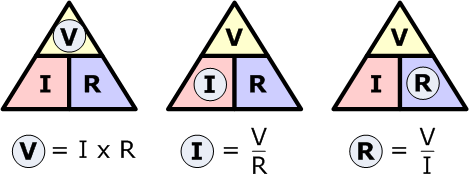Definitions
Voltage = The electrical potential difference across 2 points in a circuit (or across the terminals of a battery). Measured by a voltmeter in Volts (V or E) which is wired in parallel with the circuit.
Current = The flow of electrons measured in Amperes (I). Measured with an ammeter connected within the circuit.
Resistance = The opposition to the current flow in a circuit. Measured in Ohms (R). The resistance of any conductor (a wire for example) is determined by following 3 factors;
- The material (number of free electrons) (more free electrons = lower resistance)
- Cross sectional area (larger = lower resistance)
- Length (shorter = lower resistance)
Resistors
Every piece of wire forming a circuit and every consumer (load) in the circuit will have a certain resistance.
A resistor = component whose only function is to provide a particular resistance. Can be used to control the current flow through a circuit. A variable resistor allows the current to be varied (a dimmer switch uses a variable resistor to adjust the brightness of the instrument lighting for example).
Multiple resistors in a circuit
Resistors in a circuit can be connected either in series or in parallel;
- In series
To calculate the total resistance in the circuit, simply add them together.
Conclusion; increasing the number of resistances in series increases the total resistance and thus reduces the current flow
The disadvantage of this connection is that if a failure occurs in one consumer, it will cause the entire current flow and therefore all consumers to stop working (they are either ALL ON or ALL OFF)

- In parallel
The total resistance (Rt) is calculated in the following way;
1/Rt = 1/R1 + 1/R2 + 1/R3 + ... and so on
For example, the total resistance in the circuit shown below will be:
1/Rt = 1/15 + 1/3 + 1/7
1/Rt = 0.54
Rt = 1/0.54
Rt = 1.85 Ohms

When loads are connected in parallel, the total resistance reduces when more loads are added (in contrast to the series method). Another advantage is that a failure of one consumer does not affect the operation of the others!
Temperature and resistance
Increasing the temperature will increase the resistance in the circuit. However, some materials will work in the opposite way.
When a resistance increases with increasing temperature = material has a positive temperature coefficient (PTC)
When a resistance decreases with increases temperature = material has a negative temperature coefficient (NTC)
Ohm's Law
It defines the relationship between voltage, current and resistance in a circuit and states that:
I = V / R
Or in words: current in a circuit is directly proportional to the voltage and inversely proportional to the resistance

Work and Power
Work = Done by an electrical circuit by pushing the electrons through it and converting electrical energy into heat, magnetism or chemical energy
Power = The rate at which electrons are pushed through the circuit, measured in Watts
P = I x V

Voltage = The electrical potential difference across 2 points in a circuit (or across the terminals of a battery). Measured by a voltmeter in Volts (V or E) which is wired in parallel with the circuit.
Current = The flow of electrons measured in Amperes (I). Measured with an ammeter connected within the circuit.
Resistance = The opposition to the current flow in a circuit. Measured in Ohms (R). The resistance of any conductor (a wire for example) is determined by following 3 factors;
- The material (number of free electrons) (more free electrons = lower resistance)
- Cross sectional area (larger = lower resistance)
- Length (shorter = lower resistance)
Resistors
Every piece of wire forming a circuit and every consumer (load) in the circuit will have a certain resistance.
A resistor = component whose only function is to provide a particular resistance. Can be used to control the current flow through a circuit. A variable resistor allows the current to be varied (a dimmer switch uses a variable resistor to adjust the brightness of the instrument lighting for example).
Multiple resistors in a circuit
Resistors in a circuit can be connected either in series or in parallel;
- In series
To calculate the total resistance in the circuit, simply add them together.
Conclusion; increasing the number of resistances in series increases the total resistance and thus reduces the current flow
The disadvantage of this connection is that if a failure occurs in one consumer, it will cause the entire current flow and therefore all consumers to stop working (they are either ALL ON or ALL OFF)

- In parallel
The total resistance (Rt) is calculated in the following way;
1/Rt = 1/R1 + 1/R2 + 1/R3 + ... and so on
For example, the total resistance in the circuit shown below will be:
1/Rt = 1/15 + 1/3 + 1/7
1/Rt = 0.54
Rt = 1/0.54
Rt = 1.85 Ohms

When loads are connected in parallel, the total resistance reduces when more loads are added (in contrast to the series method). Another advantage is that a failure of one consumer does not affect the operation of the others!
Temperature and resistance
Increasing the temperature will increase the resistance in the circuit. However, some materials will work in the opposite way.
When a resistance increases with increasing temperature = material has a positive temperature coefficient (PTC)
When a resistance decreases with increases temperature = material has a negative temperature coefficient (NTC)
Ohm's Law
It defines the relationship between voltage, current and resistance in a circuit and states that:
I = V / R
Or in words: current in a circuit is directly proportional to the voltage and inversely proportional to the resistance

Work and Power
Work = Done by an electrical circuit by pushing the electrons through it and converting electrical energy into heat, magnetism or chemical energy
Power = The rate at which electrons are pushed through the circuit, measured in Watts
P = I x V


 Home
Home
